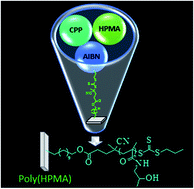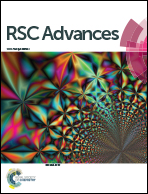Synthesis of poly(N-(2-hydroxypropyl) methacrylamide) brushes by interface-mediated RAFT polymerization†
Abstract
The synthesis of poly(N-(2-hydroxypropyl) methacrylamide) [poly(HPMA)] brushes is reported using an interface-mediated reversible addition–fragmentation chain transfer (RAFT) polymerization on a silicon substrate. To produce a RAFT agent immobilized surface, 4-cyano-4-(propylsulfanylthiocarbonyl)sulfanyl pentanoic acid was reacted with 9-decen-1-ol to form a self-assembled monolayer. Poly(HPMA) brushes and free polymers of varied molecular weights between 10 100 and 48 500 g mol−1 were then synthesized by RAFT polymerization. The chemical characterization of the modified surfaces was examined using atomic force microscopy, grazing angle-Fourier transform infrared and X-ray photoelectron spectroscopy, ellipsometry and water contact angle measurements. The average distance between grafting sites (D, nm) and grafting density (σ, chains per nm2) of poly(HPMA) brushes calculated from the dry film thickness (h, nm) and the number-average molecular weight (![[M with combining macron]](https://www.rsc.org/images/entities/i_char_004d_0304.gif) n) of the free polymers were 1.3 nm and 0.52 chains per nm2, respectively, indicating moderate density polymer brush formation.
n) of the free polymers were 1.3 nm and 0.52 chains per nm2, respectively, indicating moderate density polymer brush formation.


 Please wait while we load your content...
Please wait while we load your content...